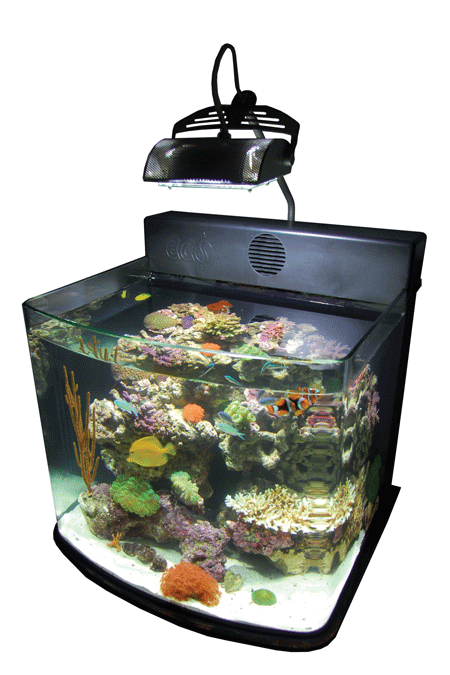 Virtually every reef aquarium hobbyist has, at one time or another, dreamed of propagating corals for a living. After learning to maintain these delicate organisms in captivity and experiencing the satisfaction of trading a few frags with fellow hobbyists and local dealers, many feel the powerful allure of coral gardening as a livelihood. However, it’s the rare individual who actually progresses beyond the dreaming stage and succeeds in transforming a fascination with coral aquaculture into a thriving business endeavor.
Virtually every reef aquarium hobbyist has, at one time or another, dreamed of propagating corals for a living. After learning to maintain these delicate organisms in captivity and experiencing the satisfaction of trading a few frags with fellow hobbyists and local dealers, many feel the powerful allure of coral gardening as a livelihood. However, it’s the rare individual who actually progresses beyond the dreaming stage and succeeds in transforming a fascination with coral aquaculture into a thriving business endeavor.
Bubble-Tip Anemones: An Overview
One of the coolest things in the ocean is symbiosis between two organisms. For example, the symbiotic relationship between clownfish and their host anemones is responsible for drawing thousands of people into the hobby. There is something mesmerizing about this interaction, which gets shown regularly on television and other media outlets.
There are several anemones that can host clownfish, but the most popular in the reef-aquarium hobby is the bubble-tip anemone. Bubble-tip anemones are, perhaps, the most desirable anemones to host clownfish. They are more colorful than most long-tentacle anemones and less predatory than carpet anemones. They’re also a lot hardier than sebae anemones and can be propagated relatively easily. Lastly, they are also known to host a wide variety of clownfish—arguably more than any other anemone in the hobby.
The ironic thing about bubble-tip anemones is that they don’t always have bubble tips. It is very common for healthy specimens to display long, stringy tentacles instead of their namesake bulb-like tips. There is much speculation around what causes this difference in morphology but no consensus.
Care Requirements: Lighting, Feeding, Flow
Bubble-tip anemones benefit from lots of light. We have kept them under a variety of lighting conditions, but a slow acclimation to higher light seems to improve their overall health and color. Bubble-tips have a strong fluorescence that is most apparent under a heavy dose of actinic lighting. The most spectacular bubble-tip coloration I’ve seen was under a mix of blue LED’s.
As for water flow, it is far better to give them plenty rather than too little. However, providing that flow can be a challenge. While it is easy to add pumps to increase flow, it’s not so easy to protect the anemones from making a suicide dive into them. Like all anemones, bubble-tips can move around on their own. In fact, this variety moves around more than just about any other kind. They can race around a tank multiple times in a single day if they want. They might stay put for months at a time and then suddenly get the itch to race around again. The problem is, they often find a way to get stuck in pumps or get flushed down an overflow. Large anemones can easily fit through the slits in an overflow box and get severely damaged.
Long story short, bubble-tips appreciate a good amount of flow, but it is wise to protect the inputs of pumps and overflows even if it means using foam that requires frequent cleaning.
Propagation
Bubble-tips anemones are among the most prolific anemones when it comes to propagation. The methods, however, vary tremendously. Some aquaculturists like to slice the anemones in half. I personally have not had great success doing this. Other methods include periodic stress. For example, an occasional change in salinity or temperature can induce splitting.
Lastly, many successful propagators attribute their good fortune to a feeding regimen that includes meaty foods like silversides. Bubble-tip anemones eat a variety of meaty foods, and we try to give them a morsel every two to three days.
Conclusion
The bubble-tip anemone makes a great addition to a reef aquarium for those hobbyists seeking a host for their clownfish.




My rose bubble tips propogate just by feeding. I also notice they are sensitive to water changes , for the better…they turn color and extend
Where is Tidal Gardens? Do you allow visits at your facility?
Hi Gus, thanks for stopping by and leaving a comment!
Tidal Gardens is located in Copley, Ohio, USA. It’s a small town near Akron, if you’re familiar. On-site visits are available by appointment. You can schedule one through their website: http://www.tidalgardens.com
If you’re not in the area, we posted photos of the facility on our Facebook page. They also have tours on their YouTube channel.
I have visited your website a few times and hope to visit your facility one day, thanks for a very nicely done article!
So what do you feed them?